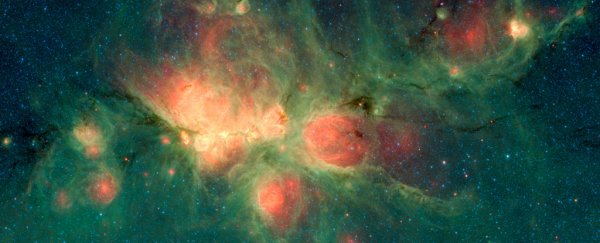Assuming life on Earth evolved out of a hearty primordial soup spiced with organic space dust, it's fair to ask how such life-generating molecules came about in the first place. We now have a much better idea, thanks to a new experiment.
Researchers from the US Lawrence Berkeley National Laboratory have shown how two relatively simple carbon molecules could combine around stars to form ringed compounds called polycyclic aromatic hydrocarbons, or PAHs.
It's these small, honeycomb-like structures that make the leap from simple strings of hydrocarbon to more complex building blocks we might associate with nucleic acids and proteins.
We already know space is dusted with the stuff. In fact, as much as 20 percent of all of the carbon in the Milky Way could be locked up inside PAHs.
It also has all of the components needed to build into larger organic materials, including 3D spherical structures such as buckyballs.
Whether biology truly started with such molecules is still a matter of debate. As are questions on how these intriguing little building blocks might form.
Fortunately chemists have plenty of ideas. Some hypotheses do a suitable job of explaining certain varieties of PAH, but they struggle to explain others, while also being too slow to account for the sheer mass of material we see in the interstellar medium.
One hypothesis suggests some short-lived carbon species with unpaired electrons – molecules known as free radicals – might collide under the right conditions to build the right kinds of ringed structures at significant rate.
It's a neat idea, but finding hard proof of this theoretical pathway hasn't been without its challenges.
"This is something that people have tried to measure experimentally at high temperatures but have not done before," said Musahid Ahmed, a chemist in Berkeley Lab's Chemical Sciences Division.
To test the idea, the researchers introduced the single-ring carbon radical 1-indenyl to a radical methyl. This took place in an environment heated to about 1,150 degrees Celsius (roughly 2,105 degrees Fahrenheit).
A device known as a reflectron time-of-flight mass spectrometer then measured the jet shooting out of the reactor at high speed, spotting a basic form of PAH with just 10 carbon atoms linked up as a pair of rings known as naphthalene.
To most of us, it's the stuff that gives moth balls their stink. To chemists, it's a potential starting place for some cool interstellar chemistry.
"For several decades, radical-radical reactions have been speculated to form aromatic structures in combustion flames and in deep space, but there has not been much evidence to support this hypothesis," said University of Hawaii chemist Ralf I. Kaiser.
Demonstrating a proof of concept like this is a significant step towards drawing a line from the fundamental physics of carbon formation all the way through to the rise of living chemistry.
Importantly, it doesn't necessarily disprove other models that could explain the formation of PAHs. The same research team has previously identified a number of avenues that warrant further investigation.
"It could be all the above, so that it isn't just one," said Ahmed. "I think that's what makes this interesting."
While we can be forgiven for the stellar origins of life holding our interest, the formation of small carbon rings also has implications for our health down here on Earth.
From burning hydrocarbon fuels and lubricants in car engines to the sizzling of bacon on the family barbeque, PAHs are also generated in quantities in our immediate surroundings.
Unfortunately for lovers of chargrilled meats, these molecules are also pretty bad for us, causing a variety of serious health conditions, including cancer.
Learning more about how they're generated just might give us enough insight to find ways to limit their production.
This research was published in Nature Communications.
